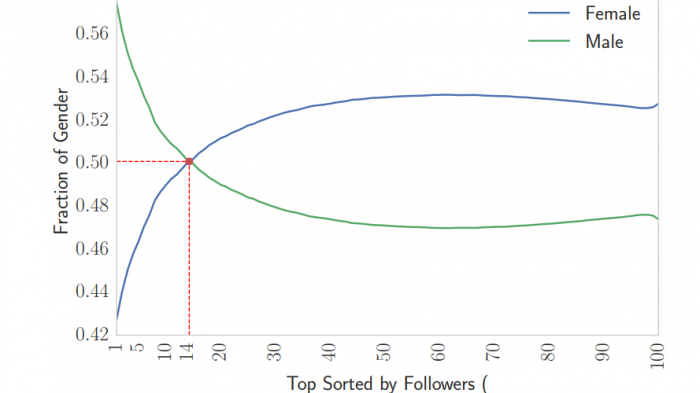Twitter’s Glass Ceiling Revealed for Women and Minority Races
Our civilization is filled with inequalities. The most obvious, involving gender and race, are the subject of ongoing study and debate. Reversing these disparities is widely considered an important goal for humanity.
One of the tools changing the way humans interact is social media. It’s natural to think that services such as Twitter can play an important role in reversing inequalities of various kinds.
But that raises an important question: to what extent have the inequalities associated with race and gender spread on social media networks already?

Today we get an answer thanks to the work of Johnnatan Messias at the Federal University of Minas Gerais in Brazil and a few pals, who have studied the playing field for men and women of different races on Twitter. Their results provide strong evidence that certain types of inequalities have already infected the Twitterverse.
The researchers’ method for studying inequality is straightforward. Messias and co began by filtering the Twitter stream during the three months to September 2016. In total, they collected 341,457,982 tweets posted by 50,270,310 users.
They filtered this by time zone, geolocation, and those with a profile picture to leave them with 1.6 million users based in the U.S. They then fed the pictures through a state-of-the-art face recognition application called Face++, which reports the sex and race (black, white, or Asian) of each user.
That revealed the overall makeup the group. This showed that 53 percent were women and 47 percent men. It also revealed the race breakdown, which was 18 percent Asian, 14 percent black, and 68 percent white.
These baseline figures are important because in a truly equal society, the same proportions should show up in subgroups of people selected from this data set.
The results make for interesting reading. Messias and co began by looking at the ratios of men and women who had the most followers on Twitter. Of the top 1 percent of Twitter users with the most followers, 57 percent were male and 43 percent female.
That’s a 15 percent swing from the distribution expected in an equal society. “The results reflect the general idea that higher positions are usually taken by males,” say Messias and co.
Similar inequalities emerged when the group studied the distribution of races among the most popular Twitter users. “At the highest levels of [Twitter] visibility, users perceived to be White come out on top position,” say the researchers.
They even tease the data apart in more detail by looking at the effects of both gender and race. The most privileged group turns out to be white males, who are overrepresented by 20 percent among popular Twitter users. White females are also more privileged albeit to much lesser extent, just 3 percent.
The most underprivileged groups are Asian females and black females, who are underrepresented by 31 percent.
Messias and co also look at the way users connect to each other and whether this reflects the baseline data. It turns out that there are significant biases in the way genders and races link to each other. This is an effect known as “homophily”—the tendency of people to seek out others like themselves.
But the magnitudes of this effect are interesting. White people tend to follow more white people than expected by a margin of 16 percent. Black people tend to follow more black people than expected by a very significant margin of over 200 percent. However, Asian people tend to follow fewer Asian people than expected by a margin of 10 percent. “The expected homophily was not clear for the case of Asians,” say Messias and co.
That’s interesting work that reveals the clear existence of glass ceiling effects on Twitter. “We show that the Twitter glass ceiling effect, typically applied to females, also occurs in Twitter for males, if they are Black or Asians,” say the researchers.
This has significant implications for the way inequality can be tackled. A first step is always understanding the nature of disparities, and this work goes some way to achieving this.
But the next stage of working out how to level the playing field is a much more difficult task.
Ref: arxiv.org/abs/1706.08619: White, Man, and Highly Followed: Gender and Race Inequalities in Twitter
Keep Reading
Most Popular
Large language models can do jaw-dropping things. But nobody knows exactly why.
And that's a problem. Figuring it out is one of the biggest scientific puzzles of our time and a crucial step towards controlling more powerful future models.
The problem with plug-in hybrids? Their drivers.
Plug-in hybrids are often sold as a transition to EVs, but new data from Europe shows we’re still underestimating the emissions they produce.
Google DeepMind’s new generative model makes Super Mario–like games from scratch
Genie learns how to control games by watching hours and hours of video. It could help train next-gen robots too.
How scientists traced a mysterious covid case back to six toilets
When wastewater surveillance turns into a hunt for a single infected individual, the ethics get tricky.
Stay connected
Get the latest updates from
MIT Technology Review
Discover special offers, top stories, upcoming events, and more.